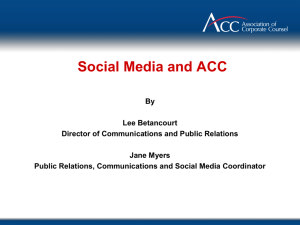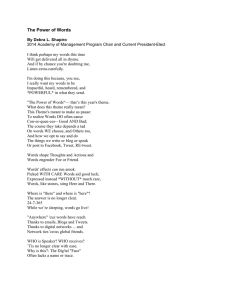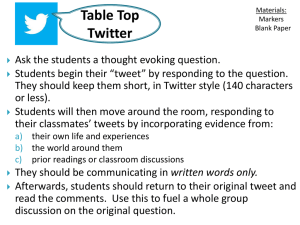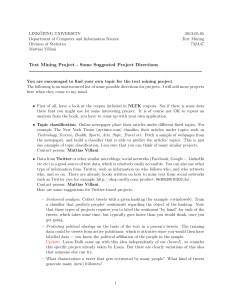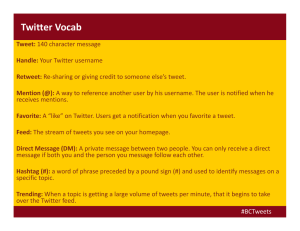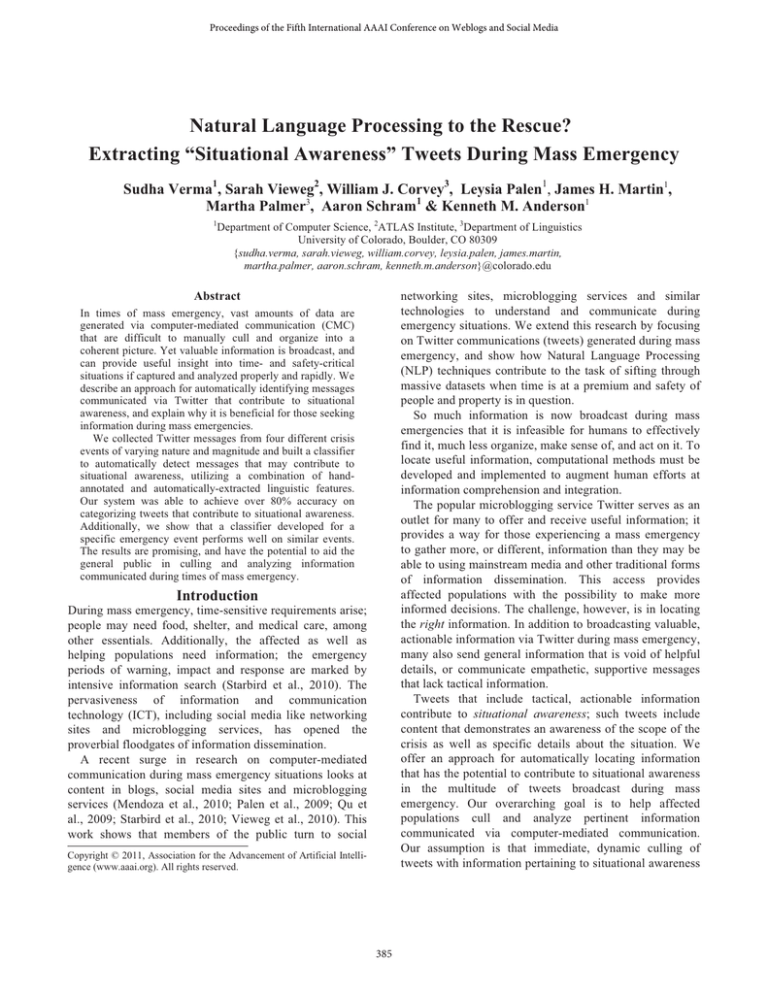
Proceedings of the Fifth International AAAI Conference on Weblogs and Social Media
Natural Language Processing to the Rescue?
Extracting “Situational Awareness” Tweets During Mass Emergency
Sudha Verma1, Sarah Vieweg2, William J. Corvey3, Leysia Palen1, James H. Martin1,
Martha Palmer3, Aaron Schram1 & Kenneth M. Anderson1
1
Department of Computer Science, 2ATLAS Institute, 3Department of Linguistics
University of Colorado, Boulder, CO 80309
{sudha.verma, sarah.vieweg, william.corvey, leysia.palen, james.martin,
martha.palmer, aaron.schram, kenneth.m.anderson}@colorado.edu
networking sites, microblogging services and similar
technologies to understand and communicate during
emergency situations. We extend this research by focusing
on Twitter communications (tweets) generated during mass
emergency, and show how Natural Language Processing
(NLP) techniques contribute to the task of sifting through
massive datasets when time is at a premium and safety of
people and property is in question.
So much information is now broadcast during mass
emergencies that it is infeasible for humans to effectively
find it, much less organize, make sense of, and act on it. To
locate useful information, computational methods must be
developed and implemented to augment human efforts at
information comprehension and integration.
The popular microblogging service Twitter serves as an
outlet for many to offer and receive useful information; it
provides a way for those experiencing a mass emergency
to gather more, or different, information than they may be
able to using mainstream media and other traditional forms
of information dissemination. This access provides
affected populations with the possibility to make more
informed decisions. The challenge, however, is in locating
the right information. In addition to broadcasting valuable,
actionable information via Twitter during mass emergency,
many also send general information that is void of helpful
details, or communicate empathetic, supportive messages
that lack tactical information.
Tweets that include tactical, actionable information
contribute to situational awareness; such tweets include
content that demonstrates an awareness of the scope of the
crisis as well as specific details about the situation. We
offer an approach for automatically locating information
that has the potential to contribute to situational awareness
in the multitude of tweets broadcast during mass
emergency. Our overarching goal is to help affected
populations cull and analyze pertinent information
communicated via computer-mediated communication.
Our assumption is that immediate, dynamic culling of
tweets with information pertaining to situational awareness
Abstract
In times of mass emergency, vast amounts of data are
generated via computer-mediated communication (CMC)
that are difficult to manually cull and organize into a
coherent picture. Yet valuable information is broadcast, and
can provide useful insight into time- and safety-critical
situations if captured and analyzed properly and rapidly. We
describe an approach for automatically identifying messages
communicated via Twitter that contribute to situational
awareness, and explain why it is beneficial for those seeking
information during mass emergencies.
We collected Twitter messages from four different crisis
events of varying nature and magnitude and built a classifier
to automatically detect messages that may contribute to
situational awareness, utilizing a combination of handannotated and automatically-extracted linguistic features.
Our system was able to achieve over 80% accuracy on
categorizing tweets that contribute to situational awareness.
Additionally, we show that a classifier developed for a
specific emergency event performs well on similar events.
The results are promising, and have the potential to aid the
general public in culling and analyzing information
communicated during times of mass emergency.
Introduction
During mass emergency, time-sensitive requirements arise;
people may need food, shelter, and medical care, among
other essentials. Additionally, the affected as well as
helping populations need information; the emergency
periods of warning, impact and response are marked by
intensive information search (Starbird et al., 2010). The
pervasiveness of information and communication
technology (ICT), including social media like networking
sites and microblogging services, has opened the
proverbial floodgates of information dissemination.
A recent surge in research on computer-mediated
communication during mass emergency situations looks at
content in blogs, social media sites and microblogging
services (Mendoza et al., 2010; Palen et al., 2009; Qu et
al., 2009; Starbird et al., 2010; Vieweg et al., 2010). This
work shows that members of the public turn to social
Copyright © 2011, Association for the Advancement of Artificial Intelligence (www.aaai.org). All rights reserved.
385
could be used to inform and update applications aimed at
helping members of the public, formal response agencies,
aid organizations and concerned outsiders understand and
act accordingly during mass emergencies.
Using NLP and machine learning (ML) techniques, we
develop a suite of classifiers to differentiate tweets across
several dimensions: subjectivity, personal or impersonal
style, and linguistic register (formal or informal style).
Based on initial analyses of tweet content, we posit that
tweets that contribute to situational awareness are likely to
be written in a style that is objective, impersonal, and
formal; therefore, the identification of subjectivity,
personal style and formal register could provide useful
features for extracting tweets that contain tactical
information. To explore this hypothesis, we study four
mass emergency events: the North American Red River
floods of 2009 and 2010, the 2009 Oklahoma grassfires,
and the 2010 Haiti earthquake.
information flow in computer-mediated communication
during and after crisis events (Palen et al., 2009), and a
growing body of research on microblogging, specifically
regarding information extraction and text-based
forecasting. Ultimately, to learn about the human practices
that motivate microblogging, one must first characterize
the structure and content of microblogs and social media at
various levels of granularity. We draw attention to several
recent studies on weblogs and social media that are
representative of three critical facets of the present
research: modeling the topic (semantic content) of a tweet
or tweet stream; modeling sentiment within the tweet; and
modeling the amount and character of subjectivity
represented in a tweet. Our classification features are
designed to not only characterize observed tweet behavior,
but to form a model that predicts the information value of
future tweets with similar characteristics based on the
information values of tweets in the training data. Because
our eventual goal is to operate in near real-time,
classification must occur quickly, over either static or
dynamic datasets. Thus, while the current study utilizes
static training data, we situate the paper within a body of
literature focused on time-series as well as static
representations of data.
Of our current classification features, two have attained
significant attention in the microblogging literature:
subjectivity and sentiment. Subjectivity classification is
presupposed in sentiment analysis, as only subjective
expressions contain sentiment-bearing constituents.
However, subjectivity classification is useful in its own
right, for discovery of sarcasm in text (Tsur et al., 2010), or
as in our data, for assessing the amount of emotion or
opinion content a user expresses in tweets, and the utility
of subjective tweets in information extraction or
assessment of situational awareness. Much research has
concerned the discovery of sentiment polarity in text (e.g.,
Bruce and Wiebe, 1999), with some recent research
correlating sentiment classification with real-world
behavior (Gilbert and Karahalios 2010; Tumasjan et al.,
2010). Our motivation for sentiment analysis in the crisis
informatics domain is to assess the polarity of the
emotional content expressed to more accurately assess
conditions on the ground.
Finally, the input for our classification scheme consists
of tweets that have been hand-labeled as on-topic. On-topic
tweets mention an event in some way (providing tactical
information,
describing
personal
reactions,
or
acknowledging that an event is occurring/has occurred.)
Previous research on crisis data (Vieweg et al., 2010) has
indicated that a simple keyword or hashtag-search
approach to tweet collection cannot guarantee extraction of
only relevant tweets. Therefore, automatic topic modeling
of tweet content is an ongoing interest (Ramage et al.,
2010).
The Disaster Events
The Red River floods occurred in March-April 2009 in
North Dakota, Minnesota, and Manitoba. The river reached
a record high level, but damage remained under control
due to mitigation efforts (Starbird et al., 2010). During the
same time period as the 2009 Red River Flood, the
Oklahoma grass fires took place on April 9-10 2009. These
fires caused over 60 injuries and burned more than 100,000
acres in central and southern Oklahoma (Vieweg et al.,
2010). Less than a year later, the Haiti earthquake on
January 12, 2010 resulted in catastrophic damage, injury
and death. The earthquake affected an entire country and
spawned an international response (Romero & Lacey
2010). Later in February-March 2010, flooding of the Red
River was again a concern. Area residents and local and
state government organizations took precautions; minimal
damage occurred (FEMA, 2010.)
Theoretical Background
When faced with mass emergency, people go through a
process of “situational analysis” (Matheus et al., 2003) to
ascertain “situational awareness” (Sarter and Woods,
1991), a state of understanding the “big picture” during
times of danger. However, having knowledge of an
emergency event at a high level—knowing that there is
threat of fire or impending flood—is not enough. People
require knowledge of fire location or flood levels, among
other details. This specific information is sometimes
communicated via Twitter, but finding it can be
cumbersome and time-consuming.
We situate this research at the intersection of crisis
informatics, the theory and practice of monitoring
386
We examine additional characteristics of discourse such
as how “personal” tweet messages are (i.e. if they indicate
shared background or understanding, and if the sender of
the tweet injects him/herself into the message in some
way) as well as linguistic register (whether they are written
in a formal or informal style). We now proceed with a
more thorough discussion of classification features and our
human annotation process.
dataset is more
communications.
representative
of
“international”
Qualitative Coding
Preliminary analysis of tweet content suggested a
correlation between tweets expressed in an objective
manner and those that contribute to situational awareness.
Such tweets communicate, for example, the location of
hazards, or the state of recovery efforts. On the other hand,
subjective tweets seem to correlate with tweets that do not
contribute to situational awareness. These tweets
communicate offers of sympathy, or requests for support or
prayer. Our subsequent analysis caused us to consider
additional linguistic styles in our examination of tweets
that contribute to situational awareness: linguistic register,
and whether tweets were written in a personal or
impersonal manner. Though all types of communications
are part of the collective behavior we observe among
Twitter users in times of mass emergency, and we do not
claim that tweets contributing to situational awareness are
more important than those that do not; it might be that
tweets with certain characteristics tend to contribute to an
action-oriented segment of the information space. Such
tweets inform decision-making processes, while other
tweets contribute to an emotion-oriented segment of the
information space.
Two annotators each independently coded a set of tweets
from each dataset for four different qualities: whether
tweets communicate situational awareness information, if
they are objective or subjective, if they are written in a
formal or informal style, and if they are written from a
personal or impersonal standpoint. An expert annotator
then adjudicated these results to form Gold Standard
training data. An explanation of each of these categories
follows, along with examples from each dataset in this
order: OK Fire, RR09, RR10, Haiti.
Tweet Content Analysis
NLP classifiers require “training” data in the form of
annotated, or coded text, which they use to “learn” how to
distinguish between different types of discourse. Discourse
analysis performed on tweets from our four datasets
provided the basis for the qualitative codes we used to
annotate tweets.
Dataset Details
For this preliminary study we collected a random sample
of roughly 500 tweets broadcast during each of the
emergency events that contained one of our keywords. 500
tweets were selected as the target because they are both a
manageable set for human annotation and
provide
sufficient training data for ML classification. The OK fire
(OK; 527 tweets) and Red River flood (RR09; 453 tweets)
were previously collected and sampled (Starbird et al.,
2010; Vieweg et al., 2010). We began the present work
using these datasets, which contained on-topic tweets
authored by individual Twitterers (i.e. not organizations or
businesses) who were located in or near an area affected by
each event.
In 2010, we collected tweets sent during the 2010 Red
River flood (RR10). The RR10 dataset was collected
during a 20-day period, from March 15-April 3 using the
following search terms: fmflood, flood10, red river,
redriver, ccflood, and fargoflood. One RR10 tweet from
the sample of 500 random tweets was off-topic, resulting in
499 tweets for the purposes of this research. The Haiti
dataset is much broader. It consists of tweets collected over
a 23-day period representing the day prior to the
earthquake until one week after the Haitian government
officially ceased search and rescue operations. The entire
Haiti dataset consists of tweets that include any of the
following search terms: haiti, earthquake, quake, shaking,
tsunami, ouest, Port-au-Prince, tremblement and
tremblement de terre. 14 Haiti tweets of the sample of 500
random tweets were off-topic, leaving us with 486 tweets.
The four datasets provide us with a variety of tweets
broadcast during three different types of mass emergency.
Our final dataset contained 1,965 tweets, all of which were
hand-annotated. In addition, the Red River and Oklahoma
datasets represent “local” communications, while the Haiti
Situational Awareness Tweet Content
Tweets were coded for whether they contribute to
situational awareness based solely on tweet text (we did
not analyze links to websites and photos). The tweets
shown below contain information that people can use to
gauge situations and inform decision-making processes;
they were coded as contributing to situational awareness:
Niece and her dad are being evac'd in MWC,
fire is headed towards SIL and her boyfriend
in Harrah
Country
residents
outside
of
Fargo
are
surrounded by flood waters. Some R being
rescued.
The Red River at Fargo ND is at 33.15 ft
which is 15.15 ft above flood stage #flood10
#fargoflood
387
Conversely, tweets that mention an event, but do not
provide actionable information, were coded as not
contributing to situational awareness. The following tweets
were coded as such—they mention the events but do not
contain information that affected populations can use to
make timely, informed decisions:
4 more GCC volunteers have deployed to Fargo
to help with the feeding and sheltering
efforts along the Red River.
Conversely, informal tweets tend to be fragmented, lacking
context, include slang and/or several abbreviations, and
have many grammatical mistakes:
Tweeps please pray for the families and
firefighters battling these crazy fires in
Oklahoma
@user6 yup homes in Tonua's neighborhood are
on fire
landed in fargo today...locals say red river
will crest at 43 feet...worse then 97 flood
Nothing upsets me more than listening to my
Dad's voice. He was born in a drought, and
now watches his hometown flood
Personal/Impersonal Tweet Content
The final quality we focused on was whether tweets were
expressed from a personal standpoint or not. Personal
tweets indicate that the Twitterer is injecting him or herself
into the situation in some way, such as these examples:
Got a flood photo of mine published in the
local paper today. Time for a new career?
Objective Tweet Content
The following tweets were coded as “objective”—they
provide purely factual information and do not express
opinions or include sentiment-bearing words:
Our best hopes and wishes go out to the folks
in Manitoba.
As the Red River is about to
crest.
OHP is responding to Cater County to assist
with RD closures and evacuations due to fires
in and near Tutums. Approx 20 homes in danger
Thinking of my friends in Fargo, and my time
spent there.
I will keep you all in my
prayers. #FMflood
Here is a list of the earthquake survivors.
You may find update from Hotel Montana:
http://bit.ly/7o7mUk
Conversely, impersonal tweets display a sense of
emotional distance from the event by the tweet author:
Subjective Tweet Content
Subjective tweets do include opinions and/or convey
sentiment, as seen below:
Canadian and Oklahoma Counties under RED FLAG
FIRE WARNING until 10 p.m.
This warning
means
conditions
are
ripe
for
wildfire
outbreaks.
so proud to be from Oklahoma. The outpouring
of support for those devestated by the fires
is amazing
The Red River at Fargo is 40.76 feet. 22.76
feet above flood stage. 0.66 feet above 1897
record. #flood09 #fargoflood
Personal/Impersonal coding can be seen as a corollary to
subjectivity analysis. Tweets that demonstrate personal
characteristics are often also subjective, but it is possible
for a tweet to contain subjective content without being
expressed from a personal point of view, and it is equally
possible for a tweet to be stated from a personal
perspective without containing subjective content, as in the
following tweet published during the Oklahoma Fires:
I think they're being a bit over dramatic
about the flooding. Trying to make us fearful
but like always it wouldn't be close to bad
at all
Register
An additional aspect of language use involves linguistic
register. According to Michael Halliday, “register is
determined by what is taking place, who is taking part, and
what part the language is playing” (Halliday, 1978, 23).
Register is frequently viewed in terms of formality—from
very formal and rigid on one end, to very casual on the
other. In the case of Twitter use during mass emergency
situations, we note that some users employ a formal
register, and others an informal register.
Formal tweets are those that are grammatically coherent
and express complete thoughts, such as these:
Staging for fires in
currently at Elk City FD
Elk
City
Area
@User13 The fires are away from our area, but
I know people who live in some of the areas
where houses burned. One works with my SIL
Qualitative Coding Results
In summary, the categories utilized in qualitative coding
are meant to satisfy three criteria. First, annotation
categories should be intuitive to annotators with minimal
training. We expect variation in agreement rates across the
datasets, and we interpret excellent agreement as an
indication of a strong delineation between a given coding
dyad on a specific disaster and poor agreement as an
is
388
3) Do the added linguistic features improve
classification of SA tweets over standard-derivable
features?
Because automatic identification of situational awareness
is a novel task, we did not have any a priori assumptions
about specific linguistic features for classification.
Therefore, as a first step, we implemented an SA classifier
based on low-level features that can be easily derived from
tweets. In parallel, we also implemented three simple
classifiers to determine linguistic features—the predicted
tags were then used as a feature for the SA Classifier and
results evaluated against the hand-annotated tags. To
determine the overall scalability of the classifier, we also
tested each classifier trained on one type of crisis-event
with data from a different event.
indication of a weak delineation of a given coding dyad.
Annotation training materials consist of token examples
and short description of each coding dyad. In addition,
annotation categories should be domain-independent.
Categories remain consistent across all datasets, and are
crisis-specific. Finally, for ease of implementation,
annotation categories are labeled as binary features. Intertagger agreement (comparing one annotator against the
other; ITA) and Kappa (κ) statistics for annotator
agreement across categories are shown in Table 1 below;
Kappa (Cohen, 1960) is the ITA adjusted for the
probability of agreement by chance. Because all codes are
binary, the probability of chance agreement is .5.
Objectivity
Register
Pers./Imp.
SA
ITA
κ
ITA
κ
ITA
κ
ITA
κ
RR09
.93
.86
.79
.57
.92
.84
.80
.60
RR10
.92
.83
.90
.80
.95
.89
.91
.81
Haiti
.89
.78
.86
.72
.86
.72
.98
.96
OK Fire
.97
.94
.90
.80
.93
.86
.91
.81
Classification Methods
We experimented with two standard machine-learning
methods for classification, Naïve Bayes (NB) and
Maximum Entropy (MaxEnt). Both have been known to do
well for the similar tasks of sentiment analysis and text
classification. MaxEnt yielded better results overall. We
used Mallet’s implementation of the algorithms
(McCallum, 2002) and made a few enhancements to Mallet
classes to process our data formats.
Table 1: ITA and Kappa statistics for inter-rater agreement
across all datasets for each annotation category.
Data Distribution
Objectivity and Personal/Impersonal codes show
consistently high agreement across datasets, which reflects
the intuitive nature of the task. Agreement on Register is
slightly lower, possibly owing to the fact that this is a more
abstract category. Additionally, the agreement values
reflect interesting variations among the datasets. For
instance, when dealing with a large-scale, catastrophic
crisis such as the Haiti earthquake, separating tweets that
mention support and prayer from Situational Awareness
tweets that offer tactical information seems more
straightforward. On the other hand, Register and
Situational Awareness may be more difficult to identify in
RR09, but it is not immediately obvious why this task is
less challenging in RR10. Below we discuss the
classification process and results.
A subset of tweets from the four events was annotated at
the tweet level to indicate four different traits. These
included whether the tweet demonstrated situational
awareness, was personal in nature, was written in a formal
register and if it was subjective. Table 2 shows the
characteristics of hand-annotated features. It shows
distribution of objective, impersonal and formal tweets
among situational aware tweets (SA) and also not
situational aware tweets (~SA).
RR09
RR10
Haiti
OK Fire
Uniform
Classification
Objective
SA
~SA
87%
56%
90%
51%
83%
50%
88%
80%
87%
53%
Impersonal
SA
~SA
88%
53%
90%
48%
78%
54%
64%
34%
81%
47%
Formal
SA
~SA
81%
46%
89%
48%
76%
41%
77%
51%
85%
44%
Table 2: Training data distribution of hand-tagged features
among the tweets that are situational aware (SA) and the tweets
that are not SA (~SA).
For machine learning, we are interested in answering the
following questions:
1) Can tweets demonstrating situational awareness
(SA tweets) be automatically identified using
machine learning techniques?
Notably, data collected from localized disasters using a
keyword search yield a high number of tweets that include
SA content. This is not surprising, as disasters such as the
Red River floods and Oklahoma fires are localized events,
and Twitter communications reflect this. However,
catastrophic disasters attaining global attention—such as
the Haiti earthquake—generate significantly more noise
and traffic on Twitter, with a smaller subset of tweets
2) How well can we categorize other linguistic traits,
such as subjectivity, which seem to co-occur with
SA tweets? Can we use existing tools to classify
well-studied concepts, such as subjectivity?
389
demonstrating situational awareness. As a point of
comparison, the average incoming tweet rate for Red River
floods generated a few thousand tweets per day, whereas
the Haiti earthquake generated up to 800K tweets per day.
We also note that a large proportion of tweets
demonstrating situational awareness are objective, formal
and impersonal in nature, confirming our belief that these
features could have the potential to improve SA
classification. On the other hand, among the messages that
do not include situational awareness information,
distribution of these features is more uniform.
Experiments and Evaluation
We implemented classifiers to predict subjectivity, register
and tone of the tweet. We evaluated the performance of the
SA classifier by introducing one feature at a time on
datasets from four different events. To get a more uniform
distribution of SA and non-SA tweets, we also created a
fifth dataset by randomly selecting 500 situational and 500
non-situational awareness tweets from all events.
Performance was evaluated by taking the mean accuracy
over 10 fold cross-validation and splitting the data 90% for
training and 10% for testing. For our baseline, we used
words (unigrams) and their frequency.
Feature Extraction
Tweets tend to include symbols and artifacts that can
confuse the classification process. We replace URLs and
Twitter-specific symbols, i.e. “RT”, “@username” and the
hash symbol (#) with a unique symbol. Standard stop
words (e.g., “a,” “the,”) were also removed. We then
tokenized the tweets and used the words and their
frequency as features for classification. We also used the
Stanford part-of-speech (POS) tagger (Toutanova et al.,
2003) to tag the tweets and use the POS tags as features.
Results
Results are detailed in Table 3. We now discuss the
relative effectiveness of individual classification features.
Words and Frequency (unigrams/bigrams)
We find high baseline accuracy for events using only word
(unigram) and raw frequency as a feature. We hypothesize
this is due to emergency events using specific vocabulary
to convey situational awareness. For example, in the case
of floods, we see that SA tweets include words such as:
“depth,” “water,” “level,” and “crested.” SA tweets for the
OKFire include: “grassfire,” “wildfire,” and “burn.” In the
uniform data split, we see higher frequency of nonspecific,
but emergency-related words: “safe,” “evacuate,” and
“rescue.” These words are infrequent in tweets that do not
include information indicating situational awareness.
The addition of bigrams to the model did not yield
significant improvement over using unigrams and
frequencies alone. This falls in line with similar work done
in sentiment analysis (e.g., Pang and Lee, 2002).
The list of features to the SA Classifier includes:
1) Unigrams and their raw frequency.
2) Bigrams and their raw frequency.
3) Part-of-speech tags.
4) Subjectivity of tweets (Objective/Subjective).
a. Hand-annotated
b. Predicted by the subjectivity classifier.
c. Derived by the OpinionFinder (Riloff and
Wiebe, 2003; Wiebe and Riloff, 2005).
5) Register of tweet (Formal/Informal)
a. Hand-annotated
b. Predicted by register classifier.
6) Tone of tweet (Personal/Impersonal)
a. Hand-annotated
b. Predicted by classifier.
Part-of-Speech Tags
We find that for most datasets, part-of-speech tags improve
Features used
Unigrams (Baseline)
Unigrams, Bigrams
Unigrams, POS
Objective (annotated), POS, unigrams
Objective (predicted), POS, unigrams
Objective (OpinionFinder), POS, unigrams
Formal (annotated), POS, unigrams
Formal (predicted), POS, unigrams
Impersonal (annotated), POS, unigrams
Impersonal (predicted), POS, unigrams
All features (predicted), POS, unigrams
RR09
NB
ME
74.0 82.2
73.2 81.1
75.3 79.1
77.7 84.0
76.5 84.8
71.5 82.4
76.4 82.7
75.2 82.1
78.2 84.0
75.9 83.9
76.1 84.1
RR10
NB
ME
74.4 89.0
71.0 88.7
80.0 87.8
82.2 88.7
81.0 88.4
76.4 85.8
82.2 88.8
80.8 87.4
82.2 89.0
81.4 87.1
80.2 88.6
Haiti
NB
ME
81.4 81.4
79.8 80.2
83.3 83.9
82.8 86.5
82.2 85.3
82.0 84.4
84.2 86.2
83.3 84.7
84.5 86.3
83.1 83.7
83.5 88.8
OKFire
NB
ME
84.3 83.4
83.2 82.4
83.2 82.6
83.8 84.1
79.4 84.7
80.2 82.6
82.3 87.9
79.8 84.4
83.0 85.5
80.2 85.1
81.0 87.1
Table 3: Average 10-fold cross validation accuracies for SA classifier. Best performance for each dataset is in boldface.
390
Uniform
NB
ME
79.8 79.3
80.3 79.8
80.8 83.3
81.0 83.0
79.2 82.3
82.3 81.9
80.0 81.8
79.7 81.3
83.8 83.5
79.8 81.5
80.2 84.5
overall classification accuracy. In addition to basic POS
tagging, we took a particular interest in tagging only
adjectives, since adjectives tend to indicate subjectivity.
This did not, however, improve the SA accuracy over POS
tags. To select messages written in a personal tone, we also
tried using POS tags only if they were personal, possessive
pronouns. This also did not help with overall accuracy,
implying that the contextual information of the tweet is
what helps with SA categorization, rather than the presence
or absence of one trait.
Summary of Feature and Accuracy Results
There is some overlap between objective, impersonal and
formal traits. For example, objective tweets tend to be
written formally and impersonally. Using any one of the
features improved the accuracy for classifying tweets with
SA content, and using all the features together helped
improve overall performance even more. The amount the
linguistic features helped varied from dataset to dataset. In
a uniform distribution, addition of the linguistic features
reduced error rate by 11% over using only part-of-speech
tags as features. However, in real crisis events, we have not
encountered uniform distributions. For disasters that are
not large-scale, keyword searches for the events yield
proportionally more SA tweets. For example, in both the
Oklahoma fire and 2009 and 2010 Red River floods, more
than 75% of the tweets included information indicating
situational awareness. Catastrophes such as the Haiti
earthquake have a greater signal to noise ratio. In both
cases, additional linguistic features greatly reduced the
error rate and improved overall accuracy of the classifier,
well beyond part-of-speech tags.
Objectivity
All tweets annotated for situational awareness were also
annotated for objectivity. We then trained a supervised
MaxEnt classifier to classify subjective and objective
tweets. We used unigrams and part-of-speech tags as input
features for the classifier. POS improved accuracy of the
subjective classification. On average, the objective
classifier achieved an accuracy of 86.2%.
We evaluated SA classifiers using both gold standard
tags and predicted tags, to see if accuracy improves when
objectivity of a tweet is available. We see the highest
increase in accuracy of the SA classifier when the gold
standard tag for objectivity is added as a feature. Predicted
objectivity tags also show good improvement in many
cases when selecting SA tweets.
We also evaluated the use of OpinionFinder for
objectivity/subjectivity analysis (Riloff and Wiebe, 2003;
Wiebe and Riloff, 2005). OpinionFinder uses lexical and
contextual information to determine a subjectivity tag, and
thus does not require us to annotate for subjectivity and
train a separate classifier. However, OpinionFinder did not
perform as well as our objectivity classifier. This is not
entirely surprising since OpinionFinder was not developed
with Twitter-like data in mind, and indicates the value of
domain-specific subjectivity classification.
Scalability Experiments and Evaluation
After examining features for improvement in classification
accuracy, we evaluated how well SA classification
performed across events. In a deployed system, we
envision a set of classifiers trained on previous events to be
used to locate SA tweets for a new event of similar type.
We used a classifier trained on data from previous
events to classify data from new events, using those
features that gave the best results in the training data. For
test data, we considered the text of the new tweets. The
MaxEnt classifier performs better on all datasets. The
results of cross-event experiments are in Table 4.
Test Set
Train Set
Haiti
RR09
RR10
OKFire
Formal Register and Impersonal Tone
Categorizing
tweets
as
Formal/Informal
and
Personal/Impersonal tended to improve situational
awareness classification. Similar to subjectivity, a MaxEnt
classifier was trained on the hand-annotated data for
predicting register of a tweet. We used the same feature set
as the subjectivity classifier. Register of a tweet proved
harder to predict than subjectivity, giving us an average
accuracy of 78.4%. The classifier to categorize tweets for
Personal and Impersonal style resulted in 85.7% average
accuracy. For both register and personal/impersonal style,
using the predicted tags yielded similar accuracies as using
the hand-annotated tags.
Haiti
50.8
52.3
29.0
RR09
69.3
80.1
81.4
RR10
73.9
83.8
OKFire
56.4
65.1
69.3
87.0
Table 4: Average 10-fold cross validation accuracies on crossevent classification using MaxEnt. Best performance in bold.
Generally, classification of a new event using a classifier
trained on previous events was more challenging, but
performance is better for events of similar type. For
instance, when a tweet was labeled using a classifier
trained on a similar disaster, results were promising; a
classifier trained on RedRiver09 gave an accuracy of 84%
on RedRiver10. The disaster in Haiti, however, differed
from others in scope of the media coverage, the type of
disaster and the extent of damage, injury and death. These
391
FEMA: National Situation Update: Wednesday, March 24, 2010.
http://www.fema.gov/emergency/reports/2010/nat032410.shtm
Gilbert, E. & K. Karahalios. 2010. Widespread Worry and the
Stockmarket. Proc. ICWSM 2010, 58-65.
Halliday, M.A.K. 1978. Language as social semiotic. Baltimore,
MD: University Park Press.
Matheus, C.J., Kokar, M.M. & K. Baclawski. 2003. A Core
Ontology for Situational Awareness. Proc. Information Fusion.
McCallum, A.K. 2002. "MALLET: A Machine Learning for
Language Toolkit." http://mallet.cs.umass.edu.
Mendoza, M., Poblete, B. & C. Castillo. 2010. Twitter Under
Crisis: Can we trust what we RT? KDD Social Media Analytics
Workshop, Proc. SOMA 2010.
Palen, L., Vieweg, S., Liu, S.B. & A.L. Hughes. 2009. Crisis in a
Networked
World:
Features
of
Computer-Mediated
Communication in the April 16, 2007 Virginia Tech Event. Social
Science Computer Review 27:4, 1-14.
Pang, B., Lee, L., Lillian & S. Vaithyanathan. 2002. Thumbs up?
Sentiment classification using machine learning techniques. In
EMNLP, 79–86.
Qu, Y., P.F. Wu, & X. Wang. 2009. Online Community Response
to Major Disaster: A Study of Tianya Forum in the 2008 Sichuan
Earthquake. Proc. HICSS 2009.
Ramage, D., Dumais, S., and D. Liebling. 2010. Characterizing
Microblogs with Topic Models. Proc. ICWSM 2010.
Riloff, E. and J. Wiebe. 2003. Learning Extraction Patterns for
Subjective Expressions. Proc. Conference on Empirical Methods
in Natural Language Processing (EMNLP-03). ACL SIGDAT,
105-112.
Romero, S. & M. Lacey. Jan. 12, 2010. New York Times. Fierce
Quake Devastates HaitianCapital,
http://www.nytimes.com/2010/01/13/world/americas/13haiti.html
Sarter, N.B. & D.D. Woods. 1991. Situation Awareness: A
Critical but Ill-Defined Phenomenon. The International Journal
of Aviation Psychology 1:1, 45-57.
Starbird, K., Palen, L, Hughes, A.L. & S. Vieweg. 2010. Chatter
on the Red: What Hazards Threat Reveals about the Social Life
of Microblogged Information. Proc. CSCW 2010, 241-250.
Toutanova, K., Klein, D., Manning, C., & Y. Singer. 2003.
Feature-Rich Part-of-Speech Tagging with a Cyclic Dependency
Network. Proc. HLT-NAACL 2003, 252-259.
Tsur, O. Davidov, D. & A. Rappoport. 2010. ICWSM—A Great
Catchy Name: Semi-Supervised Recognition of Sarcastic
Sentences in Online Product Reviews. Proc. ICWSM 2010, 162169.
Tumasjan, A., Sprenger, T.O., Sandner, P.G. & I.M. Welpe.
2010. Predicting Elections with Twitter: What 140 Characters
Reveal about Political Sentiment. Proc. ICWSM 2010, 178-185.
Vieweg, S., Hughes, A.L., Starbird, K. & L. Palen. 2010.
Microblogging During Two Natural Hazards Events: What
Twitter May Contribute to Situational Awareness. 2010. Proc.
CHI 2010, 1079-1088.
Wiebe, J.M. and E. Riloff. 2005. Creating subjective and
objective sentence classifiers from unannotated texts. Proc.
CICLing-2005.
factors most likely contributed to the poor performance
when using the Haiti dataset to classify other events and
when using other events data to classify it. These aspects
of classification will be worth exploring in our future work.
Discussion
We demonstrate that a classifier based on low-level
linguistic features performs well at identifying tweets that
contribute to situational awareness. Further, we show that
linguistically-motivated features including subjectivity,
personal/impersonal style, and register substantially
improve system performance. These results suggest that
identifying key features of user behavior can aid in
predicting whether an individual tweet will contain tactical
information. In demonstrating a link between SA and other
markable characteristics of Twitter communication, we not
only enrich our classification model, we also enhance our
perspective of the space of information disseminated
during mass emergency.
In future work, we will explore features that help lower
false positive and negative rates. False positives are of
greater concern, since they represent noise that could be
misleading. To address them, we will explore
incorporating user feedback; increasing the weight of
tweets that have been retweeted; and the effects of using
different limits in our machine learning algorithms. False
negatives represent SA messages overlooked by the
classifier. Because Twitter has a high degree of
redundancy, it is less likely that all tweets that represent
the same information and are written in different styles will
be misclassified.
To measure classifier accuracy, we tested a sample of
manually annotated tweets. As a deployed system, it will
continuously classify incoming tweets based on models
built on data from previous similar events. We will expand
our corpora both in size and event type. We will also
explore using semi-supervised approaches to increase our
coverage and depth to determine if the system scales to
different quantities of computer mediated communication.
Acknowledgements
We acknowledge sponsorship from the US National
Science Foundation (NSF) through grants IIS-0546315 and
IIS-0910586. Any opinions, findings, and conclusions or
recommendations expressed in this material are those of
the authors and do reflect the views of the NSF.
References
Bruce, R.F. & J.M. Wiebe. 1999. Recognizing subjectivity: a case
study in manual tagging.Natural Language Engineering 5:2,1-16.
Cohen, J. 1960. A Coefficient of Agreement for Nominal Scales.
Educational and Psychological Measurement 20: 37-46.
392


